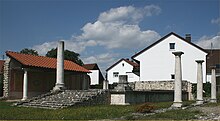Alaunus or Alaunius is a Gaulish god of healing and prophecy. His name is known from inscriptions found in Lurs, Alpes-de-Haute-Provence in Southern France and in Mannheim in western Germany. In the latter inscription, Alaunus is used as an epithet of Mercury. The feminine form Alauna is at the origin of many place-names and hydronyms across Europe, including the Roman-era names of Valognes in Normandy, Maryport and Watercrook in Cumbria, River Alyn in North Wales, Alcester in Warwickshire, Ardoch in Perthshire, and Learchild and the River Aln in Northumberland.
Artio is a Celtic bear goddess. Evidence of her worship has notably been found at Bern in Switzerland. Her name is derived from the Gaulish word for 'bear', artos.
Belenus is an ancient Celtic healing god. The cult of Belenus stretched from the Italian Peninsula to the British Isles, with a main sanctuary located at Aquileia, on the Adriatic coast. Through interpretatio romana, Belenus was often identified with Apollo, although his cult seems to have preserved a certain degree of autonomy during the Roman period.
Borvo or Bormo was an ancient Celtic god of healing springs worshipped in Gauls and Gallaecia. He was sometimes identified with the Graeco-Roman god Apollo, although his cult had preserved a high degree of autonomy during the Roman period.
In Gallo-Roman religion, Damona was a goddess worshipped in Gaul as the consort of Apollo Borvo and of Apollo Moritasgus.

In Celtic polytheism, Sirona was a goddess worshipped predominantly in East Central Gaul and along the Danubian limes. A healing deity, she was associated with healing springs; her attributes were snakes and eggs. She was sometimes depicted with Apollo Grannus or Apollo Borvo. She was particularly worshipped by the Treveri in the Moselle Valley.

Lug, Lugus (Latin), Lugos (Gaulish), also known by other names, is a god of the Celtic pantheon. His name is rarely directly attested in inscriptions, but his importance can be inferred from place names and ethnonyms and status as king of the gods. His nature and attributes are deduced from the distinctive iconography of Gallo-Roman inscriptions to Mercury, who is widely believed to have been identified with Lug, and from the quasi-mythological narratives involving his later cognates, Welsh Lleu Llaw Gyffes and Irish Lugh Lámhfhada.
In Gallo-Roman religion, Luxovios, Latinized as Luxovius, was the god of the waters of Luxeuil, worshiped in Gaul. He was a consort of Bricta. The thermal spring sanctuary at Luxeuil provided evidence of the worship of other deities, including the sky-horseman who bears a solar wheel, and Sirona, another deity associated with healing springs.

In ancient Celtic religion, Maponos or Maponus is a god of youth known mainly in northern Britain but also in Gaul. In Roman Britain, he was equated with Apollo.

In Celtic mythology, Nantosuelta is the goddess of nature, the earth, fire, and fertility
Gobannus was a Gallo-Roman smithing god.

Visucius was a Gallo-Roman god, usually identified with Mercury. He was worshipped primarily in the east of Gaul, around Trier and on the Rhine; his name is recorded on about ten dedicatory inscriptions. One such inscription has also been found in Bordeaux. Visucius is, along with Gebrinius and Cissonius, among the most common indigenous epithets of the Gaulish Mercury.
Litavis is a Gallic deity whose cult is primarily attested in east-central Gaul during the Roman period. She was probably originally an earth-goddess. In medieval Celtic languages, various terms derived from *Litauia came to designate the Brittany Peninsula.

The Eburovīcēs or Aulercī Eburovīcēs were a Gallic tribe dwelling in the modern Eure department during the Iron Age and the Roman period. They were part of the Aulerci.

The gods and goddesses of the pre-Christian Celtic peoples are known from a variety of sources, including ancient places of worship, statues, engravings, cult objects, and place or personal names. The ancient Celts appear to have had a pantheon of deities comparable to others in Indo-European religion, each linked to aspects of life and the natural world. Epona was an exception and retained without association with any Roman deity. By a process of syncretism, after the Roman conquest of Celtic areas, most of these became associated with their Roman equivalents, and their worship continued until Christianization. Pre-Roman Celtic art produced few images of deities, and these are hard to identify, lacking inscriptions, but in the post-conquest period many more images were made, some with inscriptions naming the deity. Most of the specific information we have therefore comes from Latin writers and the archaeology of the post-conquest period. More tentatively, links can be made between ancient Celtic deities and figures in early medieval Irish and Welsh literature, although all these works were produced well after Christianization.

The Leucī were a Belgic tribe dwelling in the southern part of the modern Lorraine region during the Iron Age and the Roman period.

Ballomar or Ballomarios was a leader of the Marcomanni during the Marcomannic Wars.
Candidus was a "candid spirit" that accompanied the healing god Borvo in Lusitanian and Celtic polytheism. This association is demonstrated in Nièvre at Entrains-sur-Nohain. He has been described as "a minor deity in Apollo’s train who calls to mind Apollo Virotutis ‘truth’ and Apollo's role as revealer of the truth through oracles".

Vesunna is a Celtic goddess worshipped in Roman Gaul. She was likely considered a giver of prosperity, abundance and good fortune, as evidenced by the cornucopia she is depicted carrying in her images.















